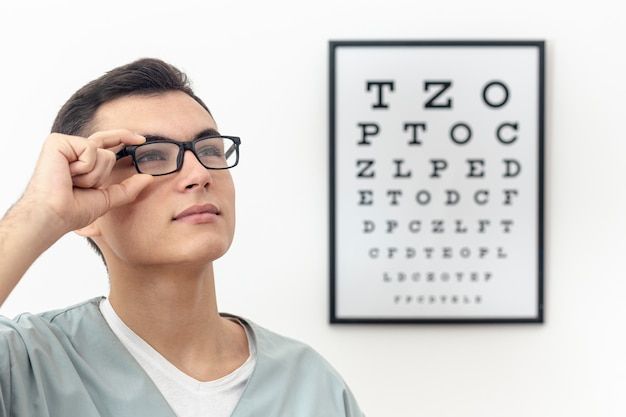How to Slow Down Myopia Progression After Turning 40

Working long hours on a computer can cause dry, tired eyes – a typical sign of vision decline after 40.
As people enter their 40s, many begin to notice that their eyesight isn’t as sharp as before, especially when reading or working on digital devices. This natural change occurs because the lens inside the eye gradually loses its flexibility, making it harder to focus on near objects. The condition is called presbyopia and often becomes more noticeable in middle age.
However, for people who already have myopia (nearsightedness), these age-related changes can make the condition progress faster. Some even experience a combination of both nearsightedness and farsightedness, which makes it difficult to focus clearly at any distance.
That’s why eye care becomes especially important at this stage. Natural vision decline, combined with lifestyle habits such as excessive screen use and limited outdoor activities, can accelerate myopia progression if not properly managed.
Main Causes of Myopia Progression After 40
As the body ages, the structure of the eyes changes as well. The lens loses its elasticity, the retina becomes more vulnerable, and the optic nerve may be affected by systemic conditions like diabetes, hypertension, or cholesterol disorders. Common causes that can make myopia progress faster include:
- Working long hours in front of screens without proper rest
- Reduced tear production leading to eye dryness and fatigue
- Wearing glasses with the wrong prescription or not updating your lenses regularly
- Side effects from chronic medications such as those for high blood pressure or arthritis
- Poor lighting when reading or working, especially in indoor office settings
These factors not only strain the eyes but can also increase the risk of faster myopia progression and early retinal damage if not detected and corrected promptly.
Warning Signs of Declining Vision

Using your phone before bedtime can lead to dry eyes, fatigue, and worsen myopia progression.
After the age of 40, if you begin to notice symptoms like blurry near vision, increased glare while driving at night, or needing to change your glasses more often, these could be signs of worsening myopia. Other symptoms to watch for include:
- Difficulty reading small print or needing to hold materials farther away
- Dry, irritated, or tired eyes after prolonged screen time
- Seeing double, experiencing blurred or floating dark spots
- Reduced ability to distinguish colors or peripheral blurriness
If you experience any of these symptoms, it’s essential to schedule an eye examination with an ophthalmologist to measure your vision accurately and assess the health of your retina.
How to Slow Myopia Progression After 40
Although developing myopia in middle age is quite common, you can still slow its progression through proper eye care and healthy habits. Eye specialists recommend:
- Regular eye check-ups: People over 40 should have a comprehensive eye exam at least every two years to detect early signs of glaucoma, macular degeneration, or changes in refractive error.
- Protect your eyes from sunlight: Sunlight, particularly ultraviolet (UV) rays, can accelerate cataract formation and damage your vision. Wear UV-protective sunglasses and a wide-brimmed hat when outdoors.

Regular eye exams help detect early vision changes and prevent progressive myopia.
- Follow a balanced work-rest schedule: Continuous work on computers and phones can cause digital eye strain. Apply the 20-20-20 rule — every 20 minutes, look at an object 20 feet away for 20 seconds to relax your eyes.
- Maintain a healthy lifestyle: Get enough sleep, avoid smoking and alcohol, and exercise regularly to promote blood circulation to the eyes and reduce overall stress.
For individuals with high myopia, besides wearing the correct prescription glasses, it’s advisable to discuss modern vision correction options with your ophthalmologist — such as Phakic ICL (Implantable Collamer Lens). This advanced solution can enhance vision without damaging the cornea and is especially suitable for middle-aged patients with thin or dry corneas.
Protecting Your Eyes from UV and Blue Light
Blue light emitted from phones, computers, and other digital devices, along with UV rays from sunlight, can accelerate the aging process of the eyes. To minimize these effects:
- Wear sunglasses outdoors to reduce UV-related cataract risks
- Use blue-light filters on your devices
- Keep a minimum distance of 40 cm when reading or working
These habits not only reduce eye strain but also prevent faster myopia progression caused by excessive artificial light exposure.
When to Visit an Eye Doctor
If you notice sudden vision changes, dark or distorted areas in your central vision, or a narrowing field of view, do not ignore these signs. They could indicate serious conditions such as macular degeneration, retinal detachment, or glaucoma — all of which become more common after 40 and can cause permanent vision loss if left untreated.
Conclusion
After turning 40, maintaining clear, healthy vision requires consistent attention and regular care. Myopia progression can be slowed down significantly through balanced habits, early detection, and timely medical guidance.
Think of your regular eye exams as your personal “vision insurance” — because protecting your sight not only supports your work and daily life but also preserves your long-term quality of living in middle age.

 vi
vi 16-Oct-2025
16-Oct-2025











 0916.741.763
0916.741.763 Appointment
Appointment